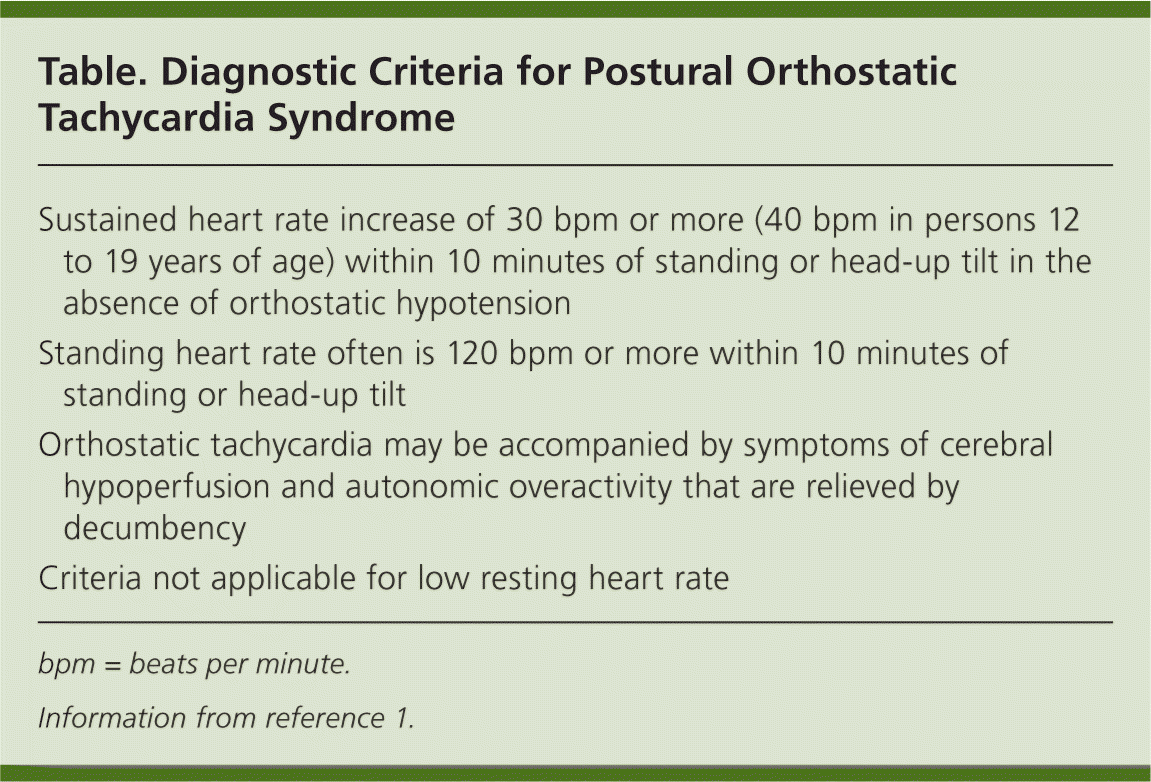
Am Fam Physician. 2012;86(5):392-394
Author disclosure: No relevant financial affiliations to disclose.
Original Article: Evaluation of Syncope
Issue Date: September 15, 2011
Available at: https://www.aafp.org/afp/2011/0915/p640.html
to the editor: This article describes the assessment of patients who lose consciousness, understandably focusing on risk stratification. However, postural orthostatic tachycardia syndrome (POTS) was omitted in the differential diagnosis of syncope.
POTS was first characterized in 1993. It is a heterogeneous group of disorders sharing similar characteristics, and is diagnosed using the stand test or tilt-table test (see accompanying table1 ). POTS is thought to affect as many as 500,000 Americans. Although there is no evidence that persons with POTS experience a reduction in life expectancy, disability can be profound and equivalent to that of persons with heart failure and chronic obstructive pulmonary disease. Twenty-five percent of patients with POTS are unable to work.2

| Sustained heart rate increase of 30 bpm or more (40 bpm in persons 12 to 19 years of age) within 10 minutes of standing or head-up tilt in the absence of orthostatic hypotension |
| Standing heart rate often is 120 bpm or more within 10 minutes ofstanding or head-up tilt |
| Orthostatic tachycardia may be accompanied by symptoms of cerebral hypoperfusion and autonomic overactivity that are relieved by decumbency |
| Criteria not applicable for low resting heart rate |
On standing, 500 mL of blood descends from the thorax. A normal autonomic nervous system adapts with immediate vasoconstriction; however, in persons with POTS, this mechanism fails and there is excessive pooling of blood. To compensate, there is an abnormal increase in heart rate (greater than 30 beats per minute) and catecholamine levels.2 Cerebral perfusion diminishes, but usually in the absence of hypotension.3
As a consequence of hypoperfusion, patients experience a multitude of symptoms, including syncope (30 to 41 percent), lightheadedness, palpitations, fatigue, headaches, mental clouding, exercise intolerance, anxiety, tremulousness, gastrointestinal upset, visual disturbance, and sweating.2,3 Symptoms are exacerbated by prolonged standing and sitting, heat, alcohol consumption, and rich meals. Because of these nonspecific symptoms, the condition is commonly misdiagnosed as anxiety, panic attacks, or chronic fatigue syndrome.
POTS tends to occur in persons 15 to 50 years of age, and is five times more common in women. Primary POTS may be of autoimmune or genetic etiology,4 and can occur after immunization, sepsis, or trauma, or during pregnancy. Secondary POTS may be caused by deconditioning, space flight, diabetes mellitus, poison ingestion, cancer, chemotherapy, joint hypermobility syndrome, and other connective tissue disorders.
Almost 90 percent of patients with POTS will respond to treatment.4 There is evidence that high fluid intake, graded exercise programs, support hosiery, and care with posture will improve symptoms.2 Pharmacologic treatments aim to increase blood volume and red blood cell mass (e.g., fludrocortisone, desmopressin, erythropoietin); vasoconstrict (e.g., midodrine, methylphenidate [Ritalin], octreotide [Sandostatin]); reduce heart rate (e.g., beta blockers); modify central neurovascular control (e.g., selective serotonin reuptake inhibitors, serotonin-norepinephrine reuptake inhibitors, clonidine [Catapres]); and facilitate neural transmission (e.g., pyridostigmine [Mestinon]).2,4
The author states that “approximately 20 to 50 percent of patients have unexplained syncope after diagnostic evaluation” and that “young patients who have frequent syncopal events, multiple vague symptoms, and no injury history should be screened for psychiatric disorders.” It would be prudent to consider POTS in this cohort of patients before recommending psychiatric evaluation.

